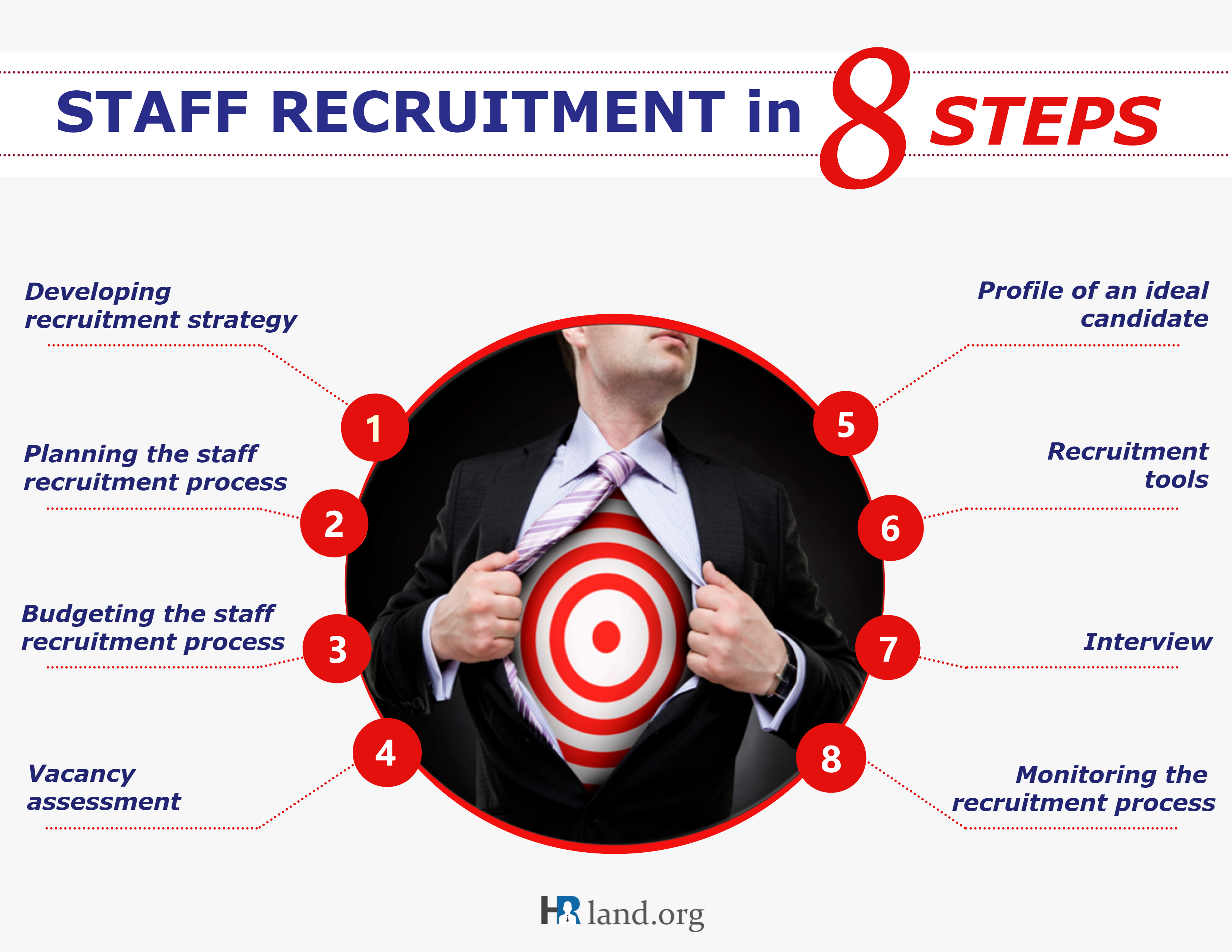Staff recruitment is a process of attracting and selecting skilled workforce, the purpose of which is to complete the staff in a well-timed and high-quality manner in accordance with the company needs.
Recruitment of qualified staff is not just simply important for any business – it is so fundamental that the significance of this HR department’s function cannot be overestimated. Every day employees who are engaged in attraction, tracking and selection of staff come across an enormous number of challenges related to business realities they are surrounded with. Their success depends not only on their professional background but also on efficient and well-organised business processes in staff recruitment sphere.
Staff recruitment: step-by-step guide

Step 1 – Developing recruitment strategy
The staff recruitment process is rather complex not only because of the need to find the competent employee but also because the process itself must be optimised taking into account such performance criteria as costs/time/quality. Recruiting a new employee should not be a problem when any of currently working employees informs you of his/her decision to leave, and you must urgently find a replacement. Attracting the best talents from the labour market requires well-thought recruitment strategy tailored to the specificities and needs of your company.
In order to decide what approach would be working for your company in the best possible way, first you should think what type of the company you have:
- What is your vision and approach to company’s growth?
- How fast does your company develop?
- How does it differ from the other companies?
- What employees do you want to hire? Do you look for candidates just to fill vacancies, or do you want the unique players with special knowledge, skills and expertise into your team?
- What growth and development opportunities do you offer to your employees?
Step 2 – Planning the staff recruitment process
Planning recruitment includes the analysis of the actual needs in staff taking into consideration the qualification, evaluation of the time input, standardised and efficient use of labour hours, timeframes and methods for finding and selecting employees.
To properly plan the recruitment the personnel plan might be helpful that includes information on:
- Optimal, actual and maximum allowed vacancy closure deadlines
- Recruiters workload at various time periods
- Methods used to find and select staff
- Allocated budget
Step 3 – Budgeting the staff recruitment process
Before launching the staff recruitment process, consider all possible costs and decide how and what you are ready to spend for it. Before starting to look for experts, analyse the labour market regarding the demand for specialists of the required profile, the salary rate offers available on the market, how attractive the working conditions offered by your company are.
When planning the recruitment budget you need to consider the following:
- The number and specific character of the offered vacancies
- Timeframes to fill the vacancies
- Average or forecast cost for closing each vacant position
- The most appropriate sources and tools for closing these
Step 4 – Vacancy assessment
The search for a new candidate always should start from the assessment of the released or newly established vacancy. It comprises:
- Position of the job in the management system (enterprise structure/department)
- Job functions, goals and objectives within the organisation structure
- Scope of authorities
- Job description
- Prospects of development for this job
- Compensation package
Step 5 – Profile of an ideal candidate
Determine what candidate you are looking for. You need to make the pictures of the ideal and suitable candidates taking into account the following information:
- Gender and age of the candidate
- Education (degree and speciality)
- Work experience
- Professional knowledge and skills
- Proficiency in foreign languages and software products
- Preferred and undesirable psychological properties and characteristics of the candidate
- List of functions the candidate will perform
- List of companies the potential jobseeker can work for
- Additional information
Step 6 – Recruitment tools
There are a lot of sources that can be used to search and select the skilled workforce. When trying to identify, which recruitment tools will be the most efficient for your organisation, you should consider the following issues:
- Are you looking for the candidate outside or within the company?
- Allocated budget
- Time limits
- Is it possible to post the vacancy in mass media?
- Availability of qualified applicants on the labour market
Step 7 – Interview
The interview is the key recruitment stage. Well-prepared interview raises the success rate of the recruitment process and the performance of the future staff dramatically. Preparing for an interview, you must clearly understand what goals you set for yourself, what your expectations from the candidate are, and what you as an employer can offer him/her.
To make the interview successful you should have:
- Time calculated on the basis of 30 minutes per each applicant
- A room prepared for an interview
- A checklist of candidates with some space for notes
- Profile (picture) of an applicant (see. step 5)
- A plan of an interview
- Itemised list of questions
- Materials for professional/psychological testing
- A set of blank forms to write the applicants’ answers
Step 8 – Monitoring the recruitment process
Traditionally, to determine the effectiveness and the quality level of the recruitment process the following metrics are used:
- Turnover rate by recruitment
- Average cost per hire
- Headhunting plan implementation
- Vacancy closure deadline
- Assessment of recruitment quality (includes the following indicators: the “cost” of recruitment, record time of an employee, revenue an expert produced for the company, achievement of the set goals by an employee)
Do you want to find a well-paid job with opportunities for career growth?

